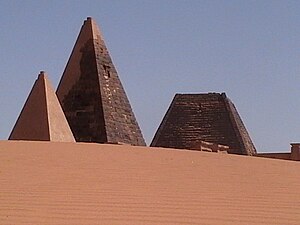Nubian pyramids

The area of the Nile valley known as Nubia that lies within present day Sudan was home to three Kushite kingdoms during antiquity: the first with its capital at Kerma (4400–1500 BC), that centred on Napata (1000–300 BC) and, finally, that of Meroë (300 BC–AD 300).
Kerma was Nubia's first centralized state with its own indigenous forms of architecture and burial customs. The last two kingdoms, Napata and Meroe, were heavily influenced culturally, economically, politically, and militarily by the powerful pharaonic Egyptian empire to the north. The Kushite kingdoms in turn competed strongly with Egypt, to the extent that during the late period of Ancient Egyptian history the rulers of Napata conquered and unified Egypt herself, ruling as the pharaohs of the Twenty-fifth Dynasty.
The Napatan domination of Egypt was relatively brief — it ended with the Assyrian conquest in 656 BC — but its cultural impact on the Napatans was enormous, and this coalesced into an extraordinary burst of pyramid-building activity that was sustained throughout the existence of Napata's successor kingdom, Meroë.
Approximately 220 pyramids were eventually constructed at three sites in Nubia over a period of a few hundred years to serve as tombs for the kings and queens of Napata and Meroë. The first of these were built at the site of el-Kurru, including the tombs of King Kashta and his son Piye (Piankhi), together with Piye's successors Shabaka, Shabataka, and Tanwetamani. Fourteen pyramids were constructed for their queens, several of whom were renowned warrior queens. Two of those were warrior queens who defeated the armies or Alexander the Great and Augustus of Rome when they attempted conquest of Nubia. This can be compared to approximately 120 pyramids that were constructed in Ancient Egypt over a period of 3000 years.
Later Napatan pyramids were sited at Nuri, on the west bank of the Nile in Upper Nubia. This necropolis was the burial place of 21 kings and 52 queens and princes. The oldest and largest pyramid at Nuri is that of the Napatan king and twenty-fifth dynasty pharaoh Taharqa.
The most extensive Nubian pyramid site is at Meroë, which is located between the fifth and sixth cataracts of the Nile, approximately one hundred kilometres north of Khartoum. During the Meroitic period over forty queens and kings were buried there.
The physical proportions of Nubian pyramids differ markedly from the Egyptian edifices that influenced them: they are built of stepped courses of horizontally positioned stone blocks, and range from approximately six to thirty metres in height, but rise from fairly small foundation footprints that rarely exceed eight metres in width, resulting in tall, narrow structures inclined at approximately seventy degrees. Most also have small Egyptian-inspired offering temple structures abutting their base. By comparison, Egyptian pyramids of similar height generally had foundation footprints that were at least five times larger and were inclined at angles of between forty and fifty degrees.
All of the pyramid tombs of Nubia were plundered in ancient times, but wall reliefs preserved in the tomb chapels reveal that their royal occupants were mummified, covered with jewellery and laid to rest in wooden mummy cases. At the time of their exploration by archaeologists in the nineteenth and twentieth centuries, some pyramids were found to contain the remains of bows, quivers of arrows, archers' thumb rings, horse harnesses, wooden boxes, furniture, pottery, colored glass, metal vessels, and many other artifacts attesting to extensive Meroitic trade with Egypt and the Hellenistic world.
See also

Known Pyramids of Other Cultures
As well as
External links
- Pyramids of Nubia – A site detailing the three major pyramid sites of ancient Nubia
- Nubian Pyramids – A site featuring numerous photographs of the pyramids at Meroë
- Aerial Photographs of Sudan – A site featuring spectacular aerial photographs of the pyramids and temples at el-Kurru, Nuri, and Meroë
- Template:Fr icon Voyage au pays des pharaons noirs Travel in Sudan and notes on the Nubian history
